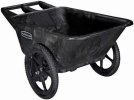Curtis is very difficult to get a grip on nowadays. I can lift his weight, but I am a very small person and Curtis is the size of my entire torso. I usually use the “bear hug” technique and cover myself in mud, but it’s getting hard to do without feeling like I’m dropping him.
Is it safe to use the overhangs of his shell above his limbs to lift him? I’ve never done it out of fear that they can’t support his weight, but I figured I’d ask because it would be very convenient.
Here’s Curtis now while I try to move him into his night box. It’s rainy and a little chilly, and he seems to have forgotten that he can walk into his house because the flaps are wet.
Is it safe to use the overhangs of his shell above his limbs to lift him? I’ve never done it out of fear that they can’t support his weight, but I figured I’d ask because it would be very convenient.
Here’s Curtis now while I try to move him into his night box. It’s rainy and a little chilly, and he seems to have forgotten that he can walk into his house because the flaps are wet.

